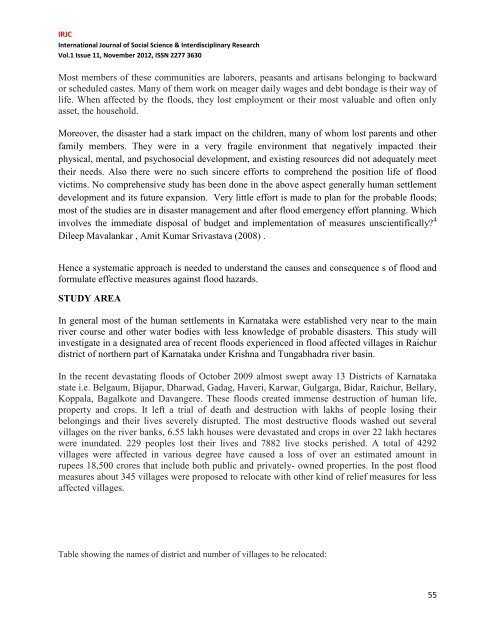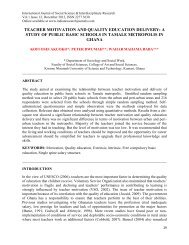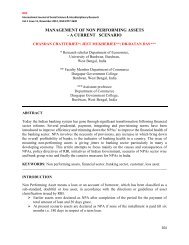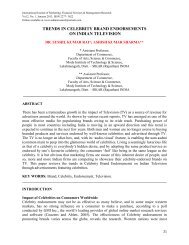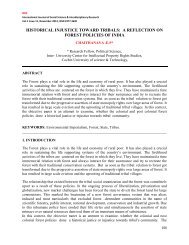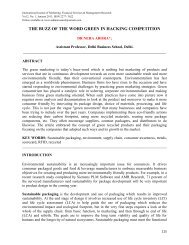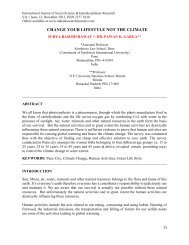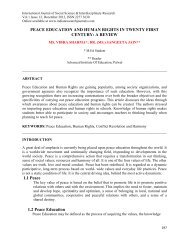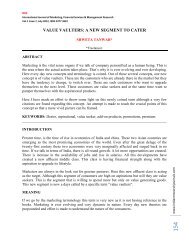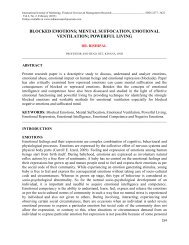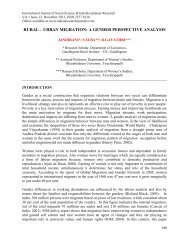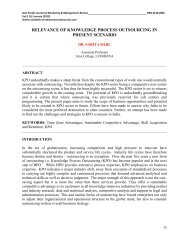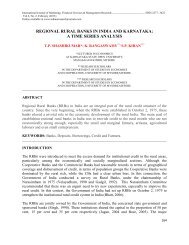application of remote sensing and gis for flood risk analysis: a case ...
application of remote sensing and gis for flood risk analysis: a case ...
application of remote sensing and gis for flood risk analysis: a case ...
You also want an ePaper? Increase the reach of your titles
YUMPU automatically turns print PDFs into web optimized ePapers that Google loves.
IRJC<br />
International Journal <strong>of</strong> Social Science & Interdisciplinary Research<br />
Vol.1 Issue 11, November 2012, ISSN 2277 3630<br />
Most members <strong>of</strong> these communities are laborers, peasants <strong>and</strong> artisans belonging to backward<br />
or scheduled castes. Many <strong>of</strong> them work on meager daily wages <strong>and</strong> debt bondage is their way <strong>of</strong><br />
life. When affected by the <strong>flood</strong>s, they lost employment or their most valuable <strong>and</strong> <strong>of</strong>ten only<br />
asset, the household.<br />
Moreover, the disaster had a stark impact on the children, many <strong>of</strong> whom lost parents <strong>and</strong> other<br />
family members. They were in a very fragile environment that negatively impacted their<br />
physical, mental, <strong>and</strong> psychosocial development, <strong>and</strong> existing resources did not adequately meet<br />
their needs. Also there were no such sincere ef<strong>for</strong>ts to comprehend the position life <strong>of</strong> <strong>flood</strong><br />
victims. No comprehensive study has been done in the above aspect generally human settlement<br />
development <strong>and</strong> its future expansion. Very little ef<strong>for</strong>t is made to plan <strong>for</strong> the probable <strong>flood</strong>s;<br />
most <strong>of</strong> the studies are in disaster management <strong>and</strong> after <strong>flood</strong> emergency ef<strong>for</strong>t planning. Which<br />
involves the immediate disposal <strong>of</strong> budget <strong>and</strong> implementation <strong>of</strong> measures unscientifically? 4<br />
Dileep Mavalankar , Amit Kumar Srivastava (2008) .<br />
Hence a systematic approach is needed to underst<strong>and</strong> the causes <strong>and</strong> consequence s <strong>of</strong> <strong>flood</strong> <strong>and</strong><br />
<strong>for</strong>mulate effective measures against <strong>flood</strong> hazards.<br />
STUDY AREA<br />
In general most <strong>of</strong> the human settlements in Karnataka were established very near to the main<br />
river course <strong>and</strong> other water bodies with less knowledge <strong>of</strong> probable disasters. This study will<br />
investigate in a designated area <strong>of</strong> recent <strong>flood</strong>s experienced in <strong>flood</strong> affected villages in Raichur<br />
district <strong>of</strong> northern part <strong>of</strong> Karnataka under Krishna <strong>and</strong> Tungabhadra river basin.<br />
In the recent devastating <strong>flood</strong>s <strong>of</strong> October 2009 almost swept away 13 Districts <strong>of</strong> Karnataka<br />
state i.e. Belgaum, Bijapur, Dharwad, Gadag, Haveri, Karwar, Gulgarga, Bidar, Raichur, Bellary,<br />
Koppala, Bagalkote <strong>and</strong> Davangere. These <strong>flood</strong>s created immense destruction <strong>of</strong> human life,<br />
property <strong>and</strong> crops. It left a trial <strong>of</strong> death <strong>and</strong> destruction with lakhs <strong>of</strong> people losing their<br />
belongings <strong>and</strong> their lives severely disrupted. The most destructive <strong>flood</strong>s washed out several<br />
villages on the river banks, 6.55 lakh houses were devastated <strong>and</strong> crops in over 22 lakh hectares<br />
were inundated. 229 peoples lost their lives <strong>and</strong> 7882 live stocks perished. A total <strong>of</strong> 4292<br />
villages were affected in various degree have caused a loss <strong>of</strong> over an estimated amount in<br />
rupees 18,500 crores that include both public <strong>and</strong> privately- owned properties. In the post <strong>flood</strong><br />
measures about 345 villages were proposed to relocate with other kind <strong>of</strong> relief measures <strong>for</strong> less<br />
affected villages.<br />
Table showing the names <strong>of</strong> district <strong>and</strong> number <strong>of</strong> villages to be relocated:<br />
55


